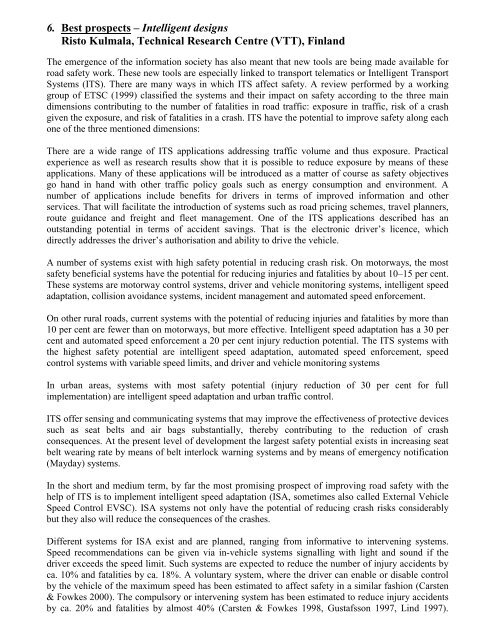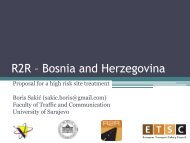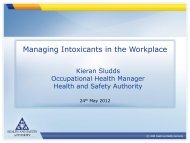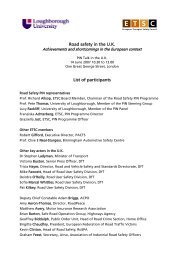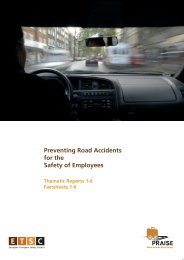BEST IN EUROPE ROAD SAFETY CONFERENCE - ETSC
BEST IN EUROPE ROAD SAFETY CONFERENCE - ETSC
BEST IN EUROPE ROAD SAFETY CONFERENCE - ETSC
You also want an ePaper? Increase the reach of your titles
YUMPU automatically turns print PDFs into web optimized ePapers that Google loves.
6. Best prospects – Intelligent designs<br />
Risto Kulmala, Technical Research Centre (VTT), Finland<br />
The emergence of the information society has also meant that new tools are being made available for<br />
road safety work. These new tools are especially linked to transport telematics or Intelligent Transport<br />
Systems (ITS). There are many ways in which ITS affect safety. A review performed by a working<br />
group of <strong>ETSC</strong> (1999) classified the systems and their impact on safety according to the three main<br />
dimensions contributing to the number of fatalities in road traffic: exposure in traffic, risk of a crash<br />
given the exposure, and risk of fatalities in a crash. ITS have the potential to improve safety along each<br />
one of the three mentioned dimensions:<br />
There are a wide range of ITS applications addressing traffic volume and thus exposure. Practical<br />
experience as well as research results show that it is possible to reduce exposure by means of these<br />
applications. Many of these applications will be introduced as a matter of course as safety objectives<br />
go hand in hand with other traffic policy goals such as energy consumption and environment. A<br />
number of applications include benefits for drivers in terms of improved information and other<br />
services. That will facilitate the introduction of systems such as road pricing schemes, travel planners,<br />
route guidance and freight and fleet management. One of the ITS applications described has an<br />
outstanding potential in terms of accident savings. That is the electronic driver’s licence, which<br />
directly addresses the driver’s authorisation and ability to drive the vehicle.<br />
A number of systems exist with high safety potential in reducing crash risk. On motorways, the most<br />
safety beneficial systems have the potential for reducing injuries and fatalities by about 10–15 per cent.<br />
These systems are motorway control systems, driver and vehicle monitoring systems, intelligent speed<br />
adaptation, collision avoidance systems, incident management and automated speed enforcement.<br />
On other rural roads, current systems with the potential of reducing injuries and fatalities by more than<br />
10 per cent are fewer than on motorways, but more effective. Intelligent speed adaptation has a 30 per<br />
cent and automated speed enforcement a 20 per cent injury reduction potential. The ITS systems with<br />
the highest safety potential are intelligent speed adaptation, automated speed enforcement, speed<br />
control systems with variable speed limits, and driver and vehicle monitoring systems<br />
In urban areas, systems with most safety potential (injury reduction of 30 per cent for full<br />
implementation) are intelligent speed adaptation and urban traffic control.<br />
ITS offer sensing and communicating systems that may improve the effectiveness of protective devices<br />
such as seat belts and air bags substantially, thereby contributing to the reduction of crash<br />
consequences. At the present level of development the largest safety potential exists in increasing seat<br />
belt wearing rate by means of belt interlock warning systems and by means of emergency notification<br />
(Mayday) systems.<br />
In the short and medium term, by far the most promising prospect of improving road safety with the<br />
help of ITS is to implement intelligent speed adaptation (ISA, sometimes also called External Vehicle<br />
Speed Control EVSC). ISA systems not only have the potential of reducing crash risks considerably<br />
but they also will reduce the consequences of the crashes.<br />
Different systems for ISA exist and are planned, ranging from informative to intervening systems.<br />
Speed recommendations can be given via in-vehicle systems signalling with light and sound if the<br />
driver exceeds the speed limit. Such systems are expected to reduce the number of injury accidents by<br />
ca. 10% and fatalities by ca. 18%. A voluntary system, where the driver can enable or disable control<br />
by the vehicle of the maximum speed has been estimated to affect safety in a similar fashion (Carsten<br />
& Fowkes 2000). The compulsory or intervening system has been estimated to reduce injury accidents<br />
by ca. 20% and fatalities by almost 40% (Carsten & Fowkes 1998, Gustafsson 1997, Lind 1997).


